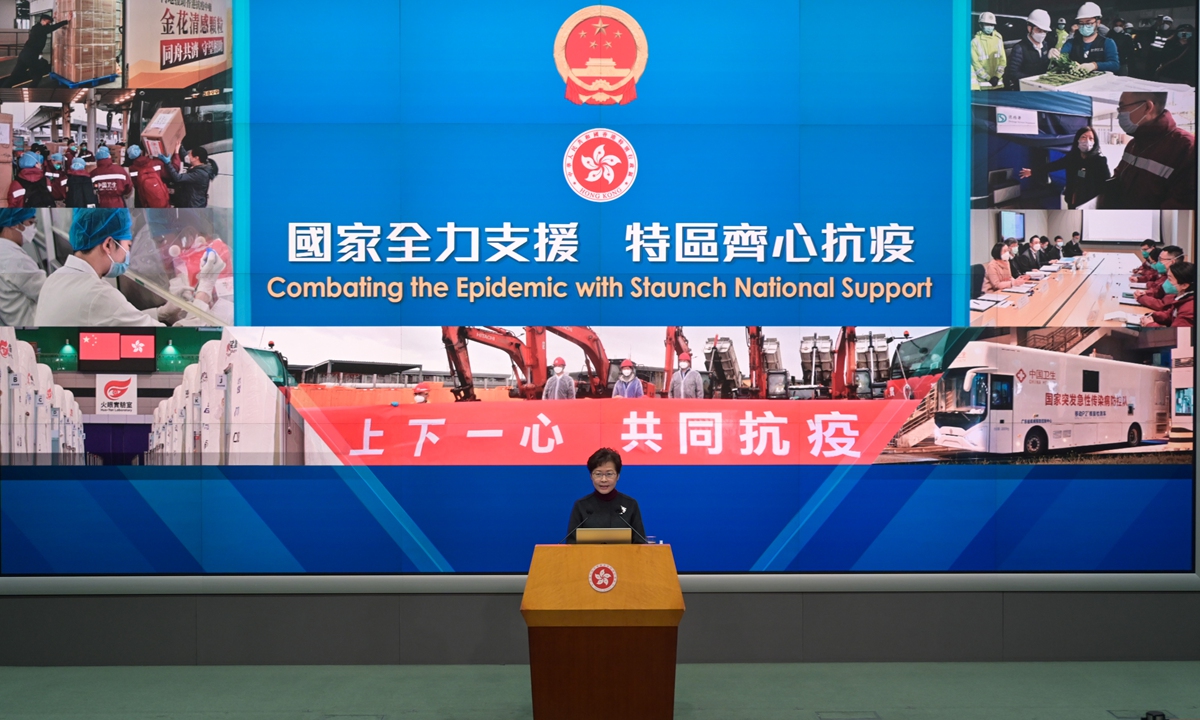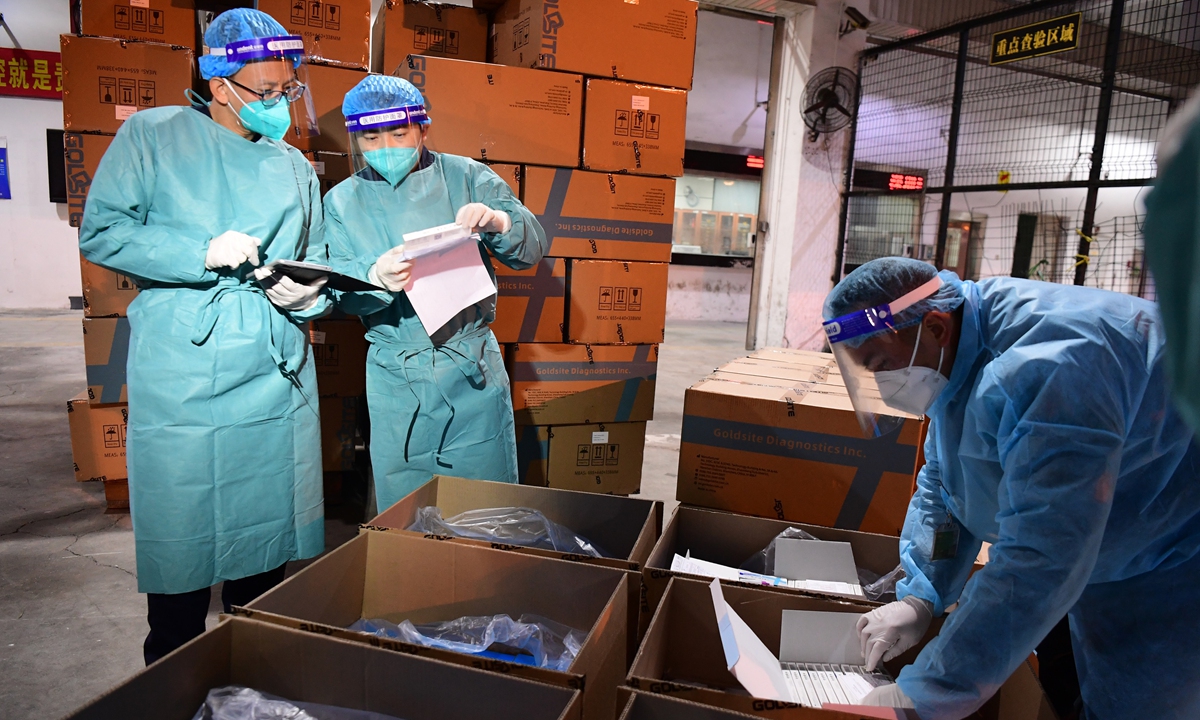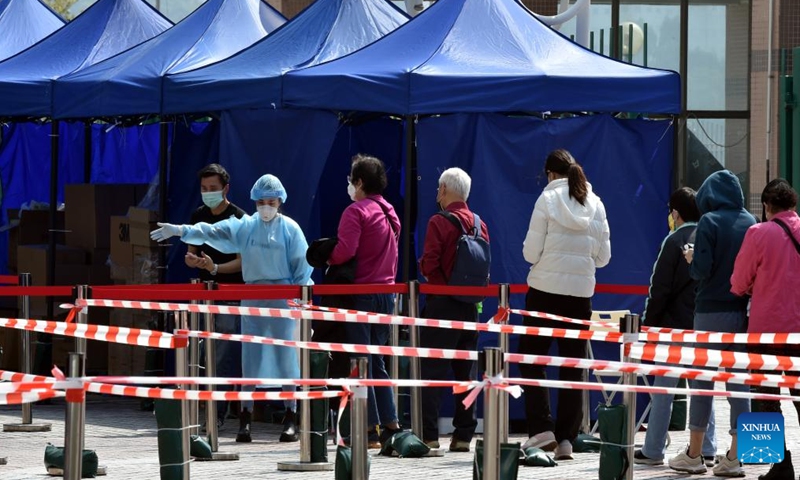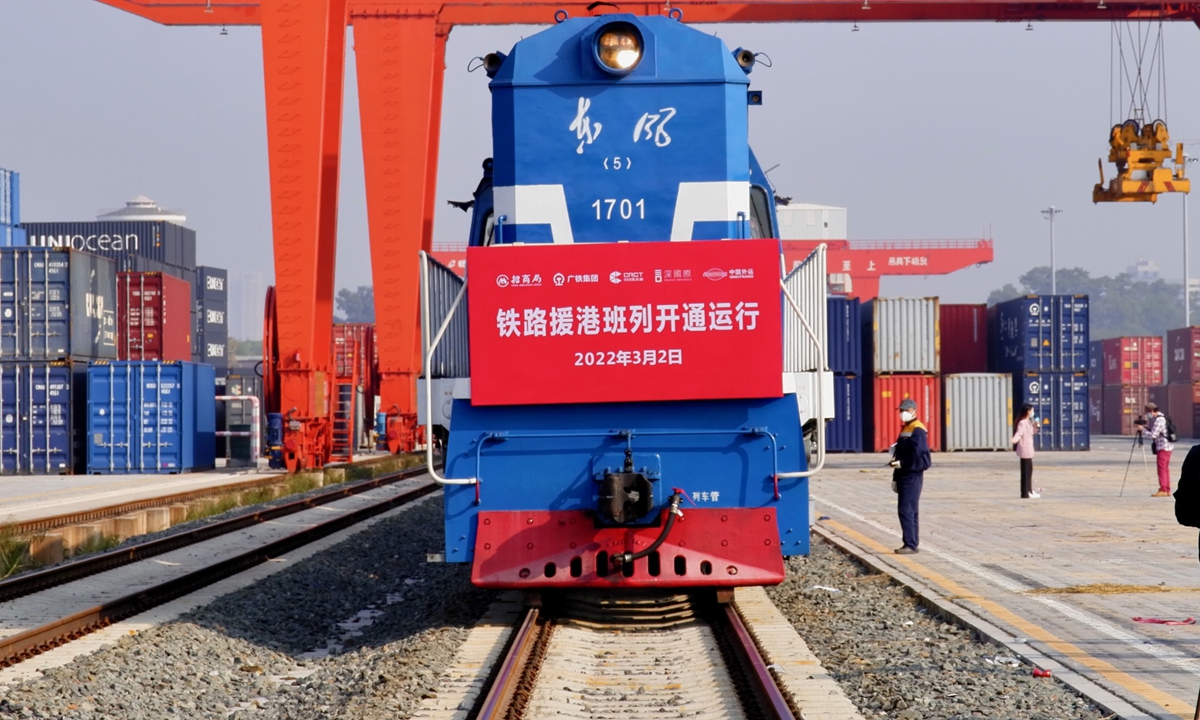
HKSAR chief executive Carrie Lam holds a press briefing on February 22, 2022, announcing that Hong Kong will launch mandatory mass nucleic acid testing in March for its residents, who are expected to receive COVID-19 tests three times within the period. Photo: VCG
For the third consecutive day, the Hong Kong Special Administrative Region (HKSAR) reported over 50,000 new daily COVID-19 infections, pushing deputies and political advisors to the National People's Congress (NPC) and Chinese People's Political Consultative Conference (CPPCC) to come up with more proposals of learning from the mainland's experiences and to fix the system bottlenecks that hinder mainland-Hong Kong cooperation on fighting the epidemic.
The SAR reported 52,523 new cases on Friday with the death toll of 136. Since the fifth wave of the outbreak, 72 percent of elderly care centers across the city reported infections, and the city's total infections since the epidemic started two years ago have surpassed 400,000.
Given such a worrisome situation, Hong Kong's largest pro-establishment party Democratic Alliance for the Betterment and Progress of Hong Kong (DAB) proposed allowing cross-border ambulances to send patients from Hong Kong to the mainland, and vice versa, without transferring to different vehicles at the border ports. This would save more time to treat patients, the DAB said. It was also one of the 21 proposals that the Hong Kong deputies and members would submit to the country's annual political meeting starting Friday.
"With the development of the Greater Bay Area, more residents in Hong Kong work and travel in the mainland. However, in emergencies, they hope to get back to Hong Kong for treatment but if the mainland's ambulance can't transfer them to Hong Kong hospitals, it would delay the treatment," Tam Yiu-chung, Hong Kong's sole deputy to the NPC Standing Committee, told the Global Times on Thursday night.

Two batches of COVID-19 antigen test kits that can cover 430,000 people are delivered from Shenzhen, South China's Guangdong Province, to the Hong Kong Special Administrative Region through a "green channel" of customs for cross-border aid on February 24, 2022. The Hong Kong SAR reported 8,798 cases on Thursday, hitting a record high amid recent surges. Photo: IC
Amid the surging number of infections, the health care system in Hong Kong is facing the risk of being overloaded, and the shortage of medical staff is the bottleneck. The HKSAR government invoked a new emergency regulation recently to provide the legal basis for anti-epidemic measures, including making more flexible and rapid use of the mainland's support and resources when needed, and carrying out key anti-epidemic projects at full speed.
With the help of the regulation, the first batch of 1,000 mainland caregivers - approximately 20 - will arrive in Hong Kong this weekend to look after elderly citizens in quarantine facilities, according to local media reports.
"Due to different systems of registering, when the central government provided assistance to Hong Kong in fighting the epidemic, we did not reach the best result, and this is also the problem we encounter during the development of 'one country, two systems,'" Tam said, noting that policymakers and advisors need to further study how to deal with such problems, aiming to put public health and lives of Hong Kong people above all and allow professionals to adopt more flexibility.

People queue up for COVID-19 tests at Tsing Yi mobile test site in Hong Kong, south China, Feb. 27, 2022. Hong Kong reported 26,026 new COVID-19 cases on Sunday, official data showed. Photo:Xinhua
Following some discussions about whether it's appropriate to launch citywide mass testing, Leung Chi-chiu, a respiratory disease expert and former chairman of the Hong Kong Medical Association's advisory committee on communicable diseases, told the Global Times on Friday that citywide nucleic acid testing is an important tool to find all cases, especially those "hidden cases" with very mild or no symptoms, to slow down the spread of the virus.
But the timing of the citywide testing should be decided based on the development of COVID-19 epidemic situations, Leung said.
He estimated that Hong Kong's daily cases entered its peak this week, and new cases are expected to drop from tens of thousands a day to thousands a day by mid-April. Leung suggested that Hong Kong should adopt antigen detection tests to find highly contagious patients and quarantine them immediately when daily cases remain at a high level and then turn to citywide nucleic acid testing to find hidden cases to achieve the goal under the dynamic zero COVID-19 policy.
Besides the cross-border ambulance proposal, Tam said the mainland's experts also bring valuable experiences to Hong Kong. By introducing the treatment of Traditional Chinese medicine, fast tracing the cases with big data and nucleic acid testing, which are the areas that the mainland and Hong Kong could work on together in the future.

The first freight train from the Chinese mainland to Hong Kong carrying anti-epidemic supplies, including more than 1.1million COVID-19 testing kits and 10,000 protective garments, launches on Wednesday. Photo: VCG
While the central government donated about 50,000 boxes of anti-epidemic proprietary Chinese medicine such as "Lianhua Qingwen," local residents have been rushing to register online to get the medicine, which paralyzed the online registration forms on noon Friday, as some local media reported.
Jonathan Choi Koon-shum, a member of the Standing Committee of the National Committee of the CPPCC, also made a similar proposal to the "two sessions" by suggesting establishing a special medical treatment zone in the Greater Bay Area.
Authorities in the area could establish a cross-border data and security standard expert team to improve and streamline access to medical data, Choi said in the proposal sent to the Global Times.
Amid the epidemic, with the HKSAR government's special assistance plan, the University of Hong Kong-Shenzhen Hospital provides subsidized consultation services for chronic disease patients living in Guangdong Province, facilitating the first cross-border exchange of medical records between the two places.
However, the support plan has many limitations, he said. For example, the coverage is limited to outpatient services for chronic diseases and only covers part of the information, excluding the detailed surgical report of the patient.
The restriction reflects the lack of policy and institutional support for data flow in the Greater Bay Area. It also shows that Hong Kong has not been able to meet the actual needs of the integrated development of the Greater Bay Area.
Faced with the severe epidemic situation, Liang Wannian, head of the central government's experts team to help the city's anti-epidemic fight, was quoted as saying in local media reports on Friday that the city should implement the past experiences and the necessary measures including the coordination among different authorities.
The HKSAR government lacks an institutional mechanism to coordinate and integrate public and private medical institutions, as well as government and private resources, to deal with the epidemic under normal circumstances, Lau Siu-kai, vice-president of the Chinese Association of Hong Kong and Macao Studies, told the Global Times on Friday.
"It also lacks the networks and capabilities to control organizations and regulate individual behavior. More important is the lack of courage to take drastic action, including the use of emergency laws to deal with crises," he said.







